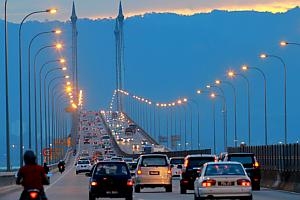Time for the next tier of ASEAN cities to stand up
Business Times |

By Parag Khanna and Mohit Mehrotra
ASEAN countries have weathered the financial crisis well. Having built up current account surpluses, controlled inflation, increased savings and investment, and lowered unemployment, Asean is enjoying - and should continue to enjoy - at least a decade or more of solid growth.
But for Asean's economies to be more resilient and equitable in the long term, they need more geographic diversity. Asean's growth story has been centred on its capitals and financial centres such as Singapore, Kuala Lumpur, Manila, Jakarta, Ho Chi Minh City, Yangon and others. Now is the time to accelerate investments into secondary cities in ways that can broaden the economic base, reduce inequality, and diversify industries.
A world of shrinking international inequality but rising domestic inequality is one where national average statistics become almost meaningless. In the largest and most geographically dispersed economies of the world - the United States, Brazil, Russia, China, India and Indonesia - the differences in prosperity between core and peripheral regions within each country have become starker than the gaps between their respective capital cities.
In this new landscape, we must think of competitiveness as much as a provincial issue as a national one. Various sub-state regions, territories, and municipalities need to have their own competitiveness strategies, or economic master plans, to capitalise on domestic growth and international connectedness.
The Asia Research Institute (ARI) at the Lee Kuan Yew School of Public Policy in the National University of Singapore has produced a very important study of the competitiveness of Asian countries' provinces. Using over 90 indicators, it ranked the 34 economies of Greater China, 35 states of India, and 33 provinces of Indonesia according to: macroeconomic stability; government and institutional setting; financial, business and manpower conditions; and quality of life and infrastructure development.
Indonesia's distribution of rankings in the ARI index is revealing as to the deep developmental divisions inherent across Asean today. Jakarta's score is 1.75, with 0 being the mean across the study. The next closest within Indonesia are Jawa Timur and Kalimantan, with scores of .66 and .55, respectively. Twenty of Indonesia's provinces had negative rankings, the lowest being Nusa Tenggara Timur. Other Asean countries exhibit similarly stark distributions. Foxconn's recent announcement that it will spend US$1 billion on new factories in Indonesia - entirely in Jakarta province - is a reminder of how investment benefits continue to accrue largely to capital regions.
Asean's stellar economic performance thus continues to mask tremendous weaknesses. As Asia comes to rely less on exports to Europe and America and more on internal trade within the region, a far-broader footprint of modernisation will be needed to sustain growth. This means ramping up the competitiveness of second-tier cities - as fast as possible.
Asean has much to learn from the performance and strategies of once second-tier Chinese cities that have now joined the global big leagues. Guangzhou and Tianjin, for example, have both risen up the global value chain substantially over the past decade through infrastructure investment, setting up special economic zones (SEZs) to attract investment and develop new industries, and expanding the role of financial institutions in lending to local and regional companies.
Some elements to consider, for an enhanced play by tier-two cities:
• Devolve but support provincial economic strategies: Increasingly it is not just countries that develop five- or 10-year visions, but cities and provinces. Each needs to determine its comparative advantages (whether manufacturing, education, eco-tourism, or other specialisations) and formulate an economic master plan to vigorously pursue them. Supporting those plans must be a foremost national priority.
• Attract capital through special economic zones: Across emerging markets, SEZs are multiplying in number in order to leapfrog opaque bureaucracies and red tape, attract manufacturing and services supply chains, and forge hybrid governance structures that fuse foreign investors with city and industry authorities. The combined effect is rapid job creation, quickly moving local economies up the global value chain, and creating positive spillovers into the rest of the province.
• Stronger focus by financial institutions: International and domestic banks based in capital cities overwhelmingly channel their lending to big projects and companies clustered around the capital itself. But commercial and retail lending to SMEs and for home mortgages needs to take place as locally as possible in order to build the housing sector and small businesses which form the backbone of the tier-two cities. Regulatory support for enhanced digital strategies by banks and non-bank financial institutions (local/foreign) will be an important element as well.
The sine qua non in bringing second-tier cities up to global standards is investment in hard and soft infrastructure. Whether largely domestic-driven (as in Vietnam) or through cross-border initiatives (as with Singapore in southern Malaysia), physical infrastructure upgrades, IT connectedness, more transparent institutions and regulations, a trained labour force, and social services (health and education) are the foundations and catalysts for building the productive capacity today's peripheral areas need to get on the map.
This process of diversifying the geographic base of growth takes time to unfold. Penang, for example, began to attract global IT companies such as Intel as early as the 1970s but is only now becoming a household name as Malaysia's second economic hub. In heavily populated and distributed countries such as Indonesia and the Philippines, it should have begun much earlier. The good news is that governments have pledged significant infrastructure spending in the years ahead. Asean's future ultimately rests on whether its second-tier cities can arrive soon at where their capitals are today.
Parag Khanna is an Adjunct Professor in the Lee Kuan Yew School of Public Policy and a Senior Fellow at the Singapore Institute of International Affairs (SIIA). Mohit Mehrotra is Executive Director in the Financial Services Consulting Practice at Deloitte.